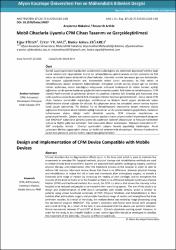| dc.contributor.author | FİDAN, Uğur | |
| dc.contributor.author | YILMAZ, Erkan | |
| dc.contributor.author | ZIĞARLI, Hatice Kübra | |
| dc.date.accessioned | 2017-10-05T08:54:10Z | |
| dc.date.available | 2017-10-05T08:54:10Z | |
| dc.date.issued | 2017 | |
| dc.identifier.issn | 2149-3367 | |
| dc.identifier.uri | http://fenbildergi.aku.edu.tr/wp-content/uploads/2017/04/015201124-130.pdf | |
| dc.identifier.uri | http://hdl.handle.net/11630/4594 | |
| dc.description.abstract | Günlük yaşam içerisindeki hareketleri sürdürmekte kullandığımız diz ekleminde dejeneratif etkilere bağlı
kronik rahatsızlıklar oluşmaktadır. Kronik diz rahatsızlıklarının giderilmesinde cerrahi yöntemler ile fizik
tedavi ve rehabilitasyon yöntemleri kullanılmaktadır. Uzmanlar cerrahi operasyon geçiren hastalardan,
tam iyileşme sağlayabilmeleri için, hastanedeki tedavi süreci sonrasında da fizik tedavi ve
rehabilitasyona devam etmelerini beklemektedir. Artroplasti cerrahi sonrası oluşan ağrı ve tromboz
riskinin azaltılması, eklem kıkırdağının iyileşmesini arttırarak fonksiyonel bir eklem hareket açıklığı
sağlanması ve diz çevresi kaslarının güçlendirilmesi amacıyla yapılan fizik tedavi ve rehabilasyonun, CPM
(Sürekli Pasif Hareket) ve geleneksel yöntem ile yapılması arasında fark olmadığı gibi hastanede veya
evde yapılması arasında da anlamlı fark olmadığını literatür taraması göstermektedir. Sonuç olarak CPM
cihazı hastane içerisindeki yoğunluğun azaltılmasına ve kişilerin kendi yaşam alanlarında tedavi
edilebilmesine olanak sağlayan bir cihazdır. Bu çalışmanın amacı ise artroplasti cerrahi sonrası kişilerin
kendi yaşam alanlarında FTR (Fiziksel Tıp ve Rehabilitasyon) tedavilerine devam etmesine olanak
sağlayarak fonksiyonel eklem hareket açıklığı kazandıran ve diz çevresi kaslarını güçlendiren, hastaların
kullanmasına alışkın olduğu mobil cihazlarla uyumlu, CPM cihazının tasarlanması ve
gerçekleştirilmesidir. Çalışma sonucunda tasarımı yapılan cihazın çalışma testleri biyomekanik programı
olan KİNOVEA® kullanılarak görüntü işleme ile yapılmıştır. Sistemin ekstansiyon ve fleksiyon hareketleri
yüksüz ve 9kg’lık yükle test edilmiştir. Test sonucunda cihazın ekstansiyon - fleksiyon hareketlerini 0° -
120° aralığında, 3mm/s - 12mm/s ayarlanabilir çalışma hızında yapabildiği ölçülmüştür. Ancak
çalışmanın klinikte uygulanabilir olması için farklı yük seviyelerinde ekstansiyon - fleksiyon hareketlerini
kararlı hale getirecek yeni bir kontrol algoritması geliştirilmelidir. | en_US |
| dc.description.abstract | Chronic disorders due to degenerative effects occur in the knee joint which is used to maintain the
movements in everyday life. Surgical methods, physical therapy and rehabilitation methods are used
to relieve chronic knee discomforts. Experts are expected from patients undergoing surgery, continue
physical therapy and rehabilitation after the treatment process in the hospital in order to able to
achieve full recovery. Literature review shows that there is no difference between physical therapy
and rehabilitation to reduce the risk of pain and thrombosis after arthroplasty surgery, to provide a
functional joint range of motion by increasing the healing of joint cartilage, and to strengthen the
muscles of the knee at home or in the hospital as there is no difference between Continuous Passive
Motion (CPM) and traditional method. As a result, the CPM is a device that allows the intensity in the
hospital to be reduced and people to be treated in their own living spaces. The aim of this study is to
design and implementation of CPM device compatible with mobile devices, which is familiar to
patients using allows functional continuity of PMR (Physical Medicine and Rehabilitation) in their
habitats after arthroplasty surgery and provides functional range of motion and strengthens the knee
perimeter muscles. As a result of the study, the realized device was tested by image processing using
the biomedical program KINOVEA®. The system’s extension and flexion were tested with unloaded
and a load of 9 kg. As a result of the test, it was measured that the device can perform extensorflexion
movements between 0o and 120o at 3mm/s - 12mm/s adjustable working speed. However, in
order for the study to be clinically feasible, a new control algorithm should be developed to stabilize
the movement of the extremity - flexures at different load levels. | en_US |
| dc.language.iso | tur | en_US |
| dc.publisher | Afyon Kocatepe Üniversitesi, Fen ve Mühendislik Bilimleri Dergisi | en_US |
| dc.identifier.doi | 10.5578/fmbd.54007 | en_US |
| dc.rights | info:eu-repo/semantics/openAccess | en_US |
| dc.subject | CPM | en_US |
| dc.subject | Artroplasti | en_US |
| dc.subject | Ekstansiyon | en_US |
| dc.subject | Fleksiyon | en_US |
| dc.subject | Mobil Cihazlar | en_US |
| dc.subject | FTR | en_US |
| dc.title | Mobil Cihazlarla Uyumlu CPM Cihazı Tasarımı ve Gerçekleştirilmesi | en_US |
| dc.title.alternative | Design and Implementation of CPM Device Compatible with Mobile Devices | en_US |
| dc.type | article | en_US |
| dc.relation.journal | Fen ve Mühendislik Bilimleri Dergisi | en_US |
| dc.department | Afyon Kocatepe Üniversitesi, Mühendislik Fakültesi, Biyomedikal Mühendisliği Bölümü | en_US |
| dc.identifier.volume | 17 | en_US |
| dc.identifier.startpage | 124 | en_US |
| dc.identifier.endpage | 130 | en_US |
| dc.identifier.issue | 1 | en_US |
| dc.relation.publicationcategory | Makale - Ulusal Hakemli Dergi - Kurum Yayını | en_US |



















